No.3 – カヤに恋して 世界農業遺産の徳島剣山系支援協議会 会長 永井 英彰
はじめに、忌部族の拠点地となる剣山系は、2018年3月にFAO(世界食糧農業機関)が提唱する世界農業遺産に認定されました。その柱は、永続的な傾斜地農業を営むために、カヤを利用することにあります。そこで、前徳島剣山世界農業遺産支援協議会の会長でもあった永井英彰さんに日本語と英語で書いていただきました。
カヤに恋して
世界農業遺産の徳島剣山系支援協議会 会長 永井 英彰
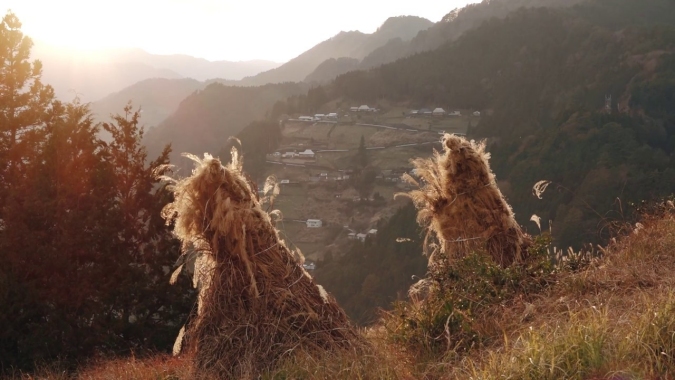
カヤとは屋根を葺くのに用いる草木の総称である。チガヤ、ススキ、アシ、ヨシなどを言う。背丈が1~1.5mのススキが代表的である。
カヤは極寒地を除いて、東南アジアをはじめ世界各地に自生している。このカヤが今回のテーマである。何故なら、カヤが国土を救うキーであるからだ。
私は10年前から仲間と共に、徳島にある最高峰剣山(標高1955m)一帯の農法を、世界農業遺産への認定を目指して活動してきた。剣山系は30度を超す急傾斜地を、段々畑にせず球形のまま、つまり等高線の畝に沿って耕作をするというユニークな農業を紀元前から続けている。根拠はこの地区のお堂に石棒が残されていることで、石棒は縄文時代の遺品だからである。
ここでは谷ごとに日当たりを考えたり、土壌流出を考えてカヤを敷いたり、石垣を組むなどの工夫を凝らしている。山が深いため日本ミツバチの宝庫であり、巨樹も鎮守の森ごとに残っている。東南アジア共通の発酵文化や干し物文化があり、畑や先祖に対する信仰も豊かである。
カヤは極寒地を除いて、東南アジアをはじめ世界各地に自生している。このカヤが今回のテーマである。何故なら、カヤが国土を救うキーであるからだ。
私は10年前から仲間と共に、徳島にある最高峰剣山(標高1955m)一帯の農法を、世界農業遺産への認定を目指して活動してきた。剣山系は30度を超す急傾斜地を、段々畑にせず球形のまま、つまり等高線の畝に沿って耕作をするというユニークな農業を紀元前から続けている。根拠はこの地区のお堂に石棒が残されていることで、石棒は縄文時代の遺品だからである。
ここでは谷ごとに日当たりを考えたり、土壌流出を考えてカヤを敷いたり、石垣を組むなどの工夫を凝らしている。山が深いため日本ミツバチの宝庫であり、巨樹も鎮守の森ごとに残っている。東南アジア共通の発酵文化や干し物文化があり、畑や先祖に対する信仰も豊かである。
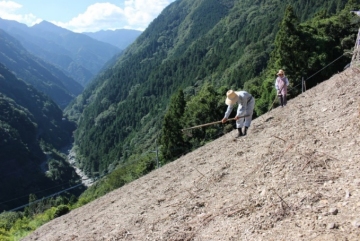

これらの中でその中核をなすものはカヤの有効利用にあると見た。つまり、多くは秋にカヤを刈り、それを円錐形に纏めて数ヶ月乾かす。それを屋根に使ったり、風よけにしたり、畑の土止めにしたり、肥料にも使う。カヤの切り口には酵素が含まれており、野菜が良く育つ土壌を作る。私は急傾斜地でなく、40アールの平地でカヤ敷農法を実験したが、無農薬で有機肥料だけの栽培でにもかかわらず、十分な成果を得た。
2017年3月、私はネパールへカヤの調査に出掛けた。カトマンズ近郊の農村でわずか数キロしか離れていない2つの村を見学した。1つの村は川辺でカヤに火を着けて燃やした後がある。その理由は邪魔なカヤを刈るためには鎌や手袋がいるが、そんなお金がないという。すぐ横には竹を材料にしたハウスにカチカチの硬い土で野菜を栽培していた。川辺のカヤを刈ってハウスの土の上に置くだけで、素晴らしい土壌ができるのにそうしていない。近くの別の村では道路脇にイネのワラを積んである。果樹園に入ると、カヤを樹木の根に積んであるし、土に潤いがある。つまり、カヤを大切に利用していることが分る。
案内人に何故こんなに違うのかを訊いた。貧しい地区は共産党系で、裕福な地区は国民党系で、双方仲が悪いからだという。私は「貧しい地区が少しでも増産になれば、国全体の経済が向上する。どうかカヤの効用を貧しい地区に教えてあげて欲しい」と要請して、帰国した。
10年前まではカヤは土中に漉き込んでいた。しかしその後に、カヤを土の上に置くだけで良い結果が得られることが分かった。
2017年3月、私はネパールへカヤの調査に出掛けた。カトマンズ近郊の農村でわずか数キロしか離れていない2つの村を見学した。1つの村は川辺でカヤに火を着けて燃やした後がある。その理由は邪魔なカヤを刈るためには鎌や手袋がいるが、そんなお金がないという。すぐ横には竹を材料にしたハウスにカチカチの硬い土で野菜を栽培していた。川辺のカヤを刈ってハウスの土の上に置くだけで、素晴らしい土壌ができるのにそうしていない。近くの別の村では道路脇にイネのワラを積んである。果樹園に入ると、カヤを樹木の根に積んであるし、土に潤いがある。つまり、カヤを大切に利用していることが分る。
案内人に何故こんなに違うのかを訊いた。貧しい地区は共産党系で、裕福な地区は国民党系で、双方仲が悪いからだという。私は「貧しい地区が少しでも増産になれば、国全体の経済が向上する。どうかカヤの効用を貧しい地区に教えてあげて欲しい」と要請して、帰国した。
10年前まではカヤは土中に漉き込んでいた。しかしその後に、カヤを土の上に置くだけで良い結果が得られることが分かった。

Burned-out of Kaya in Nepal
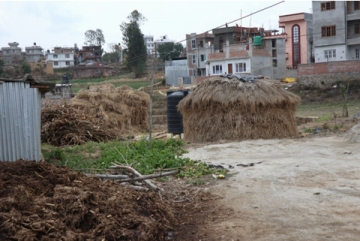

Enriched soil, that is laid Kaya
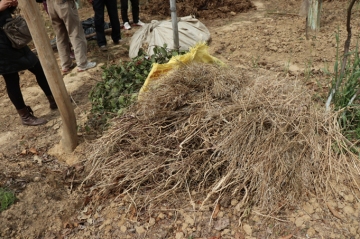
Enriched soil, that is laid Kaya
なお、徳島の剣山系は2018年3月9日、世界農業遺産に認定されました。
I love to Kaya
Hideaki Nagai (The principal of congress for supporting traditional agriculture around Mt. Tsurugi: the world agricultural heritage
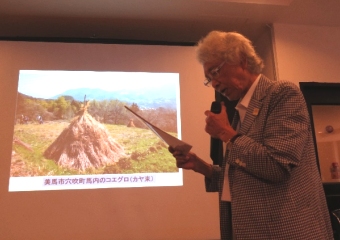
Kaya is growing abundantly in Southeast Asia and elsewhere in the world except for extreme cold areas. This Kaya is the theme of this paper, because it has the key role for saving the country.
I have been studying on the agricultural method of the foot area of Mt. Turugi(1955 m above sea level) in Tokushima with my colleague for these 10 years in order to register it as a world agricultural heritage. The Mt. Turugi aria system have been kept as an unique agriculture of cultivating steep slopes beyond 30 degrees, not as a gradual field but as a spherical shape, that is, along the ridges of contour lines. I guess that this agricultural method continue from 2 thousand years ago. The reason is that stone bars are left in the hall of this district, because stone bars are a relic of the Jomon period.
Here, I think about sunshine for every valley, ingraining kaya, thinking about soil runoff, and constructing stone walls. Because the mountain is deep, it is a treasure trove of Japanese bees, and the big trees remain in every forest of guardians. There is a common fermentation culture and a culture in Southeast Asia, and there is also abundance of faith in fields and ancestors.
I deeply thought of something which is the core among these, I saw it as being effective use of Kaya. In other words, many mow Kaya in autumn, dry it for several months by putting it in a conical shape. I use it for the roof, because it is breathe, we use it as a fertilizer. As Kaya’s cut contain an enzyme called endophyte, it creates soil where vegetables grow well.
I experimented with the Kaya-Shiki farming method on a flatland of 40 areas instead of a steep slope, but despite cultivating only organic fertilizer with organic pesticide, I got enough results.
I undertook a field survey for studying the agricultural method using Kaya in Nepal. I took a look of two villages located in several kilometers distance each other. I found burned-out site of Kaya along a river in a village. Village people made excuses for it because they have no money for buying sickles or groves. They are growing vegetables using a hard soil in a house made of bamboo nearby. I thought if they may use Kaya for change the soil for enriched one just by putting Kaya on the hard soil.
Then I visited anther village, and there I found the stackings of rice strewes along the road. I also found that Kaya was laid around fruit trees and enriched soil for agriculture in this village. This means that people use Kaya for agriculture effectively.
I asked my travel guide about the reason about this difference between these two villages. He explained that the former poor one is a communist village whereas latter rich one is a nationalist village, and conflicting each other. I suggested him about the importance of growth of agricultural products in poor village that would contribute on the economic growth in this country. Furthermore, I proposed the donation of my own money for buying sickles or groves for them. I really requested him to teach those poor people about the usefulness of Kaya for agriculture. Then, I went back to Japan.
Formerly, Kaya was mixed with soil until 10 years ago around Mt. Tsurugi. However, recent studies showed that equivalent effect was expected by just Kaya putting on the soil. I would like to recommend this simple method for Malaysian farmers as well.
I would like to thank all the collaborators because this style of traditional agriculture around Mt.Tsurugi was nominated as the world agricultural heritage at 9th Marth, 2018. I really appreciate for all the people who concerning this.
I have been studying on the agricultural method of the foot area of Mt. Turugi(1955 m above sea level) in Tokushima with my colleague for these 10 years in order to register it as a world agricultural heritage. The Mt. Turugi aria system have been kept as an unique agriculture of cultivating steep slopes beyond 30 degrees, not as a gradual field but as a spherical shape, that is, along the ridges of contour lines. I guess that this agricultural method continue from 2 thousand years ago. The reason is that stone bars are left in the hall of this district, because stone bars are a relic of the Jomon period.
Here, I think about sunshine for every valley, ingraining kaya, thinking about soil runoff, and constructing stone walls. Because the mountain is deep, it is a treasure trove of Japanese bees, and the big trees remain in every forest of guardians. There is a common fermentation culture and a culture in Southeast Asia, and there is also abundance of faith in fields and ancestors.
I deeply thought of something which is the core among these, I saw it as being effective use of Kaya. In other words, many mow Kaya in autumn, dry it for several months by putting it in a conical shape. I use it for the roof, because it is breathe, we use it as a fertilizer. As Kaya’s cut contain an enzyme called endophyte, it creates soil where vegetables grow well.
I experimented with the Kaya-Shiki farming method on a flatland of 40 areas instead of a steep slope, but despite cultivating only organic fertilizer with organic pesticide, I got enough results.
I undertook a field survey for studying the agricultural method using Kaya in Nepal. I took a look of two villages located in several kilometers distance each other. I found burned-out site of Kaya along a river in a village. Village people made excuses for it because they have no money for buying sickles or groves. They are growing vegetables using a hard soil in a house made of bamboo nearby. I thought if they may use Kaya for change the soil for enriched one just by putting Kaya on the hard soil.
Then I visited anther village, and there I found the stackings of rice strewes along the road. I also found that Kaya was laid around fruit trees and enriched soil for agriculture in this village. This means that people use Kaya for agriculture effectively.
I asked my travel guide about the reason about this difference between these two villages. He explained that the former poor one is a communist village whereas latter rich one is a nationalist village, and conflicting each other. I suggested him about the importance of growth of agricultural products in poor village that would contribute on the economic growth in this country. Furthermore, I proposed the donation of my own money for buying sickles or groves for them. I really requested him to teach those poor people about the usefulness of Kaya for agriculture. Then, I went back to Japan.
Formerly, Kaya was mixed with soil until 10 years ago around Mt. Tsurugi. However, recent studies showed that equivalent effect was expected by just Kaya putting on the soil. I would like to recommend this simple method for Malaysian farmers as well.
I would like to thank all the collaborators because this style of traditional agriculture around Mt.Tsurugi was nominated as the world agricultural heritage at 9th Marth, 2018. I really appreciate for all the people who concerning this.

